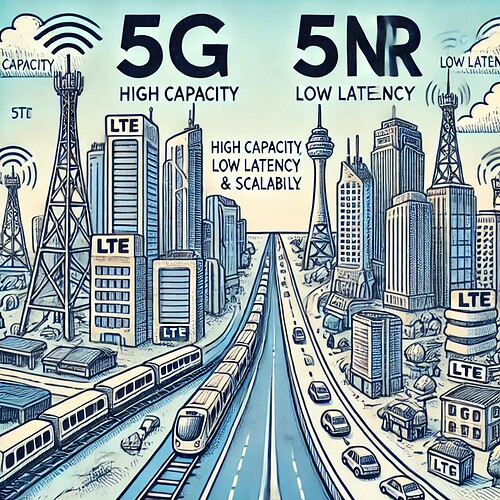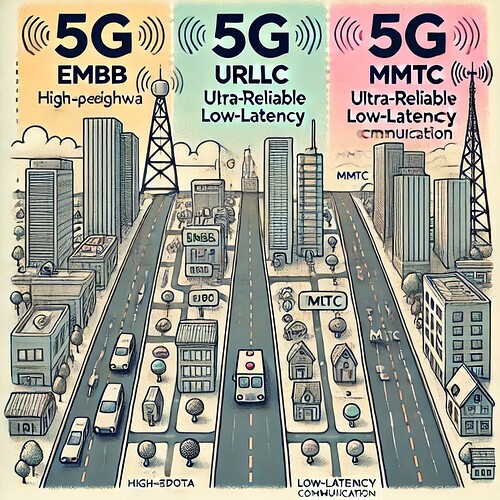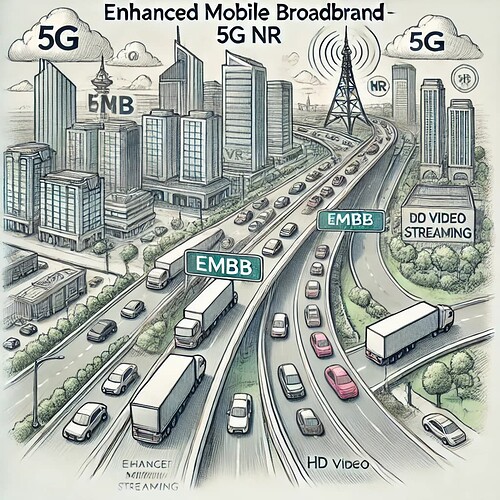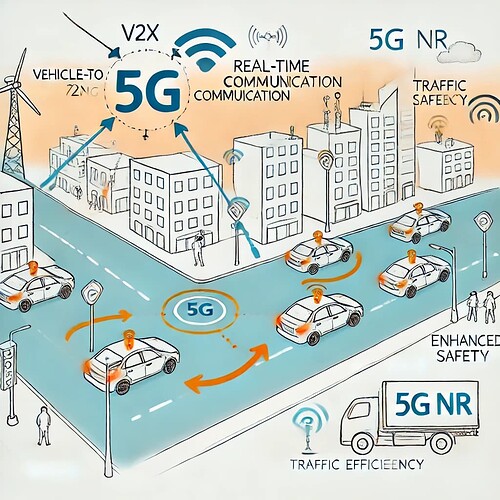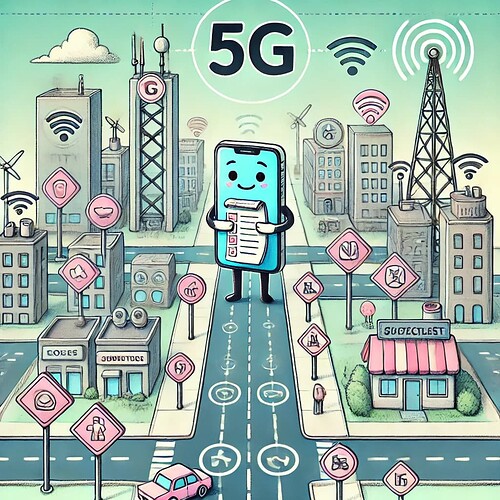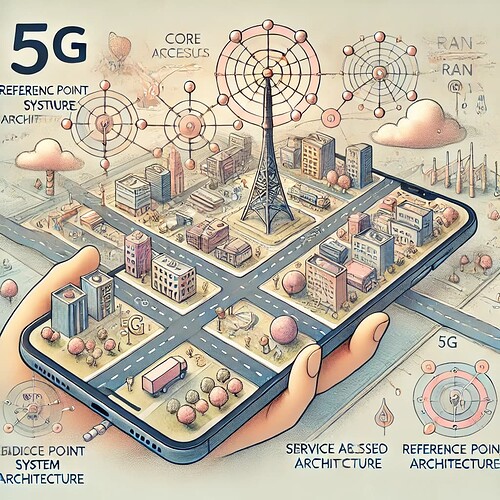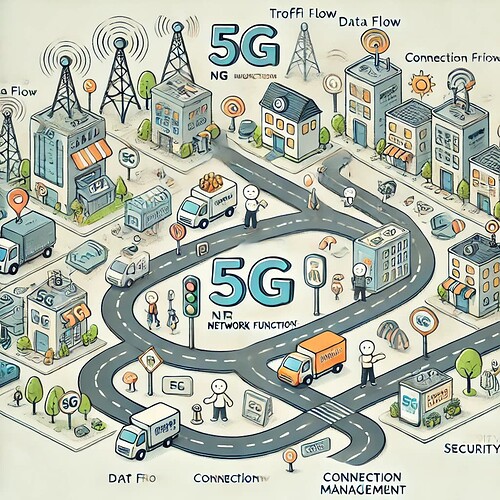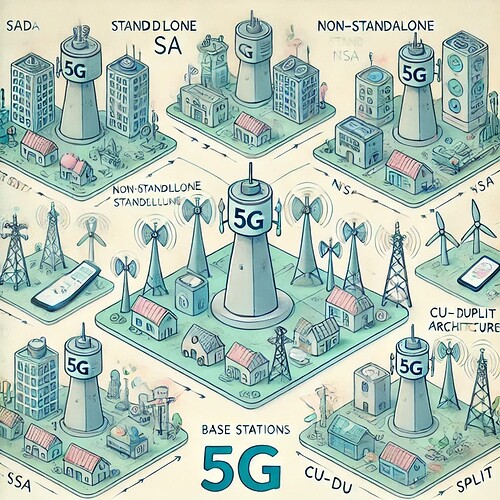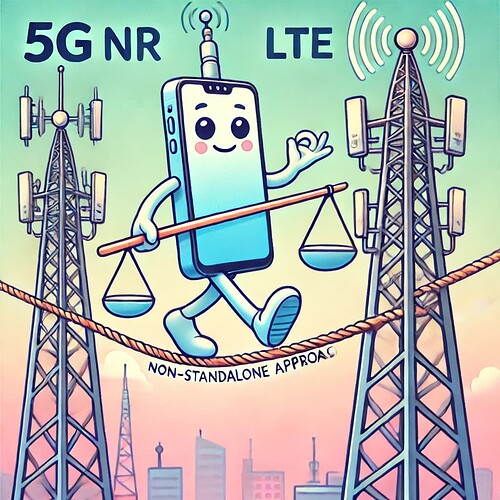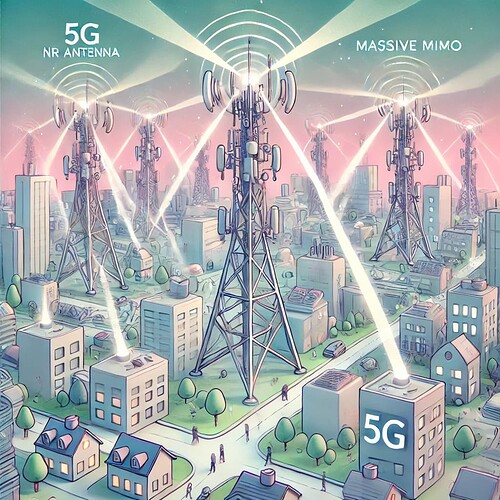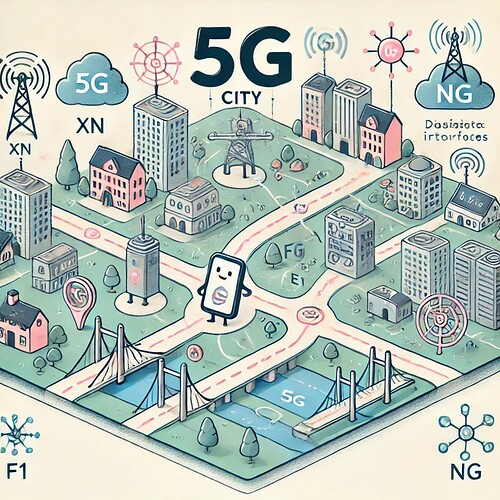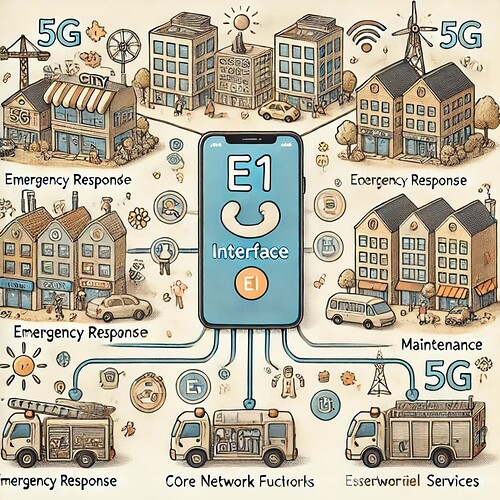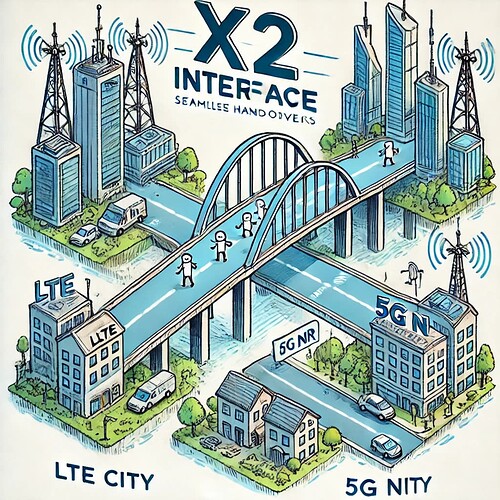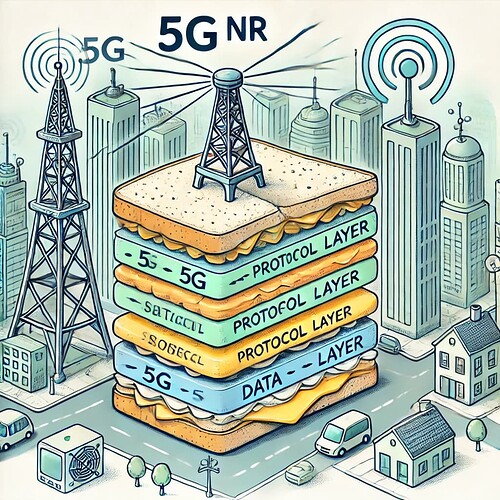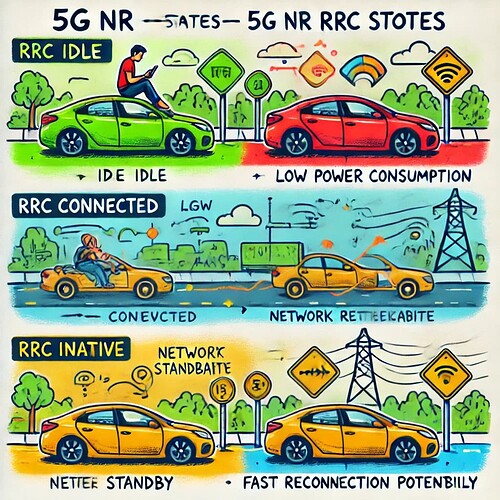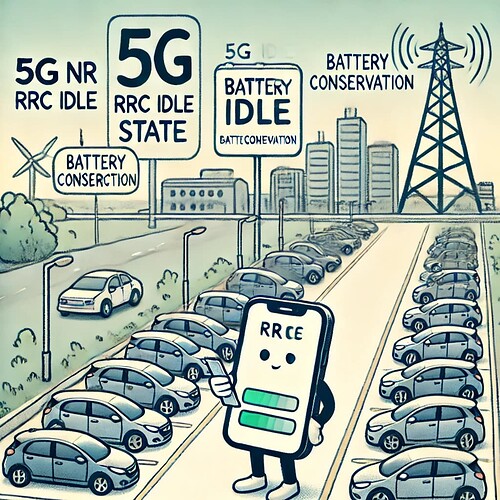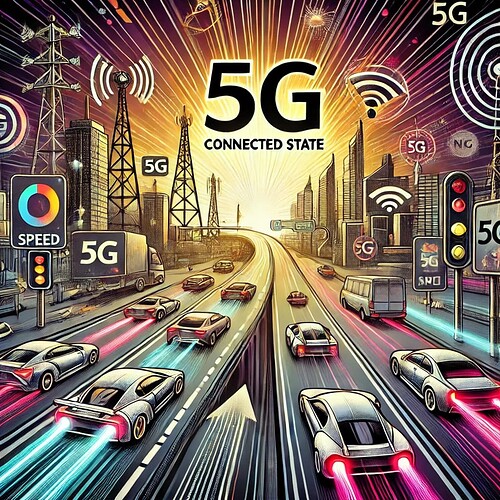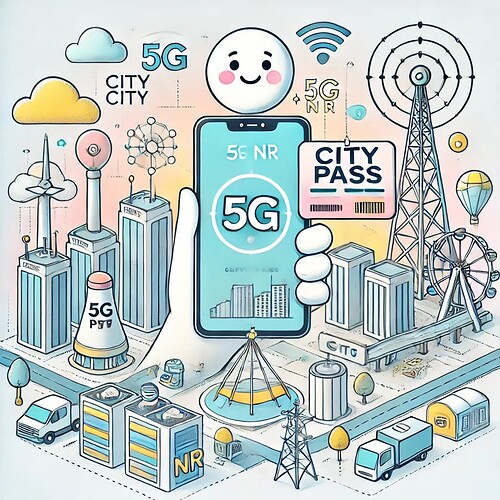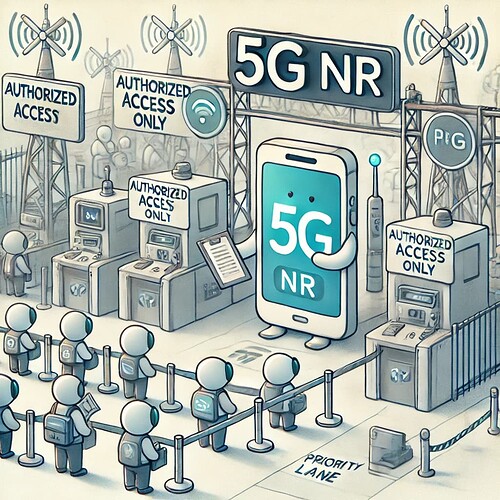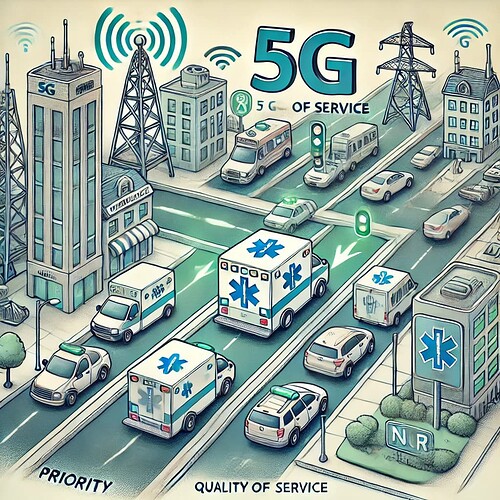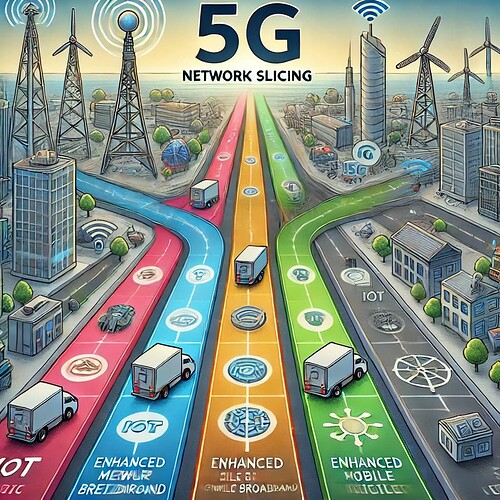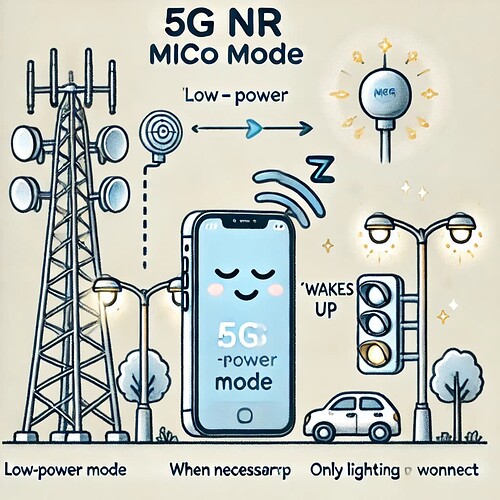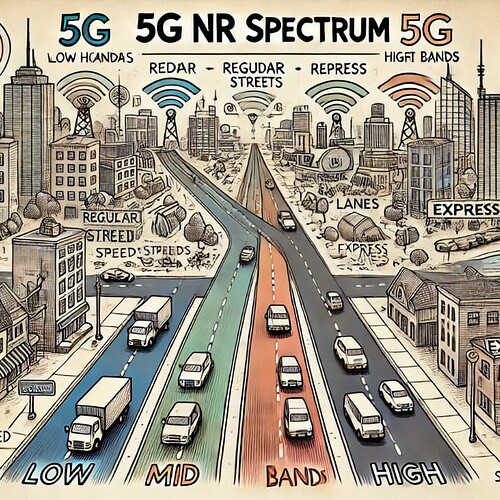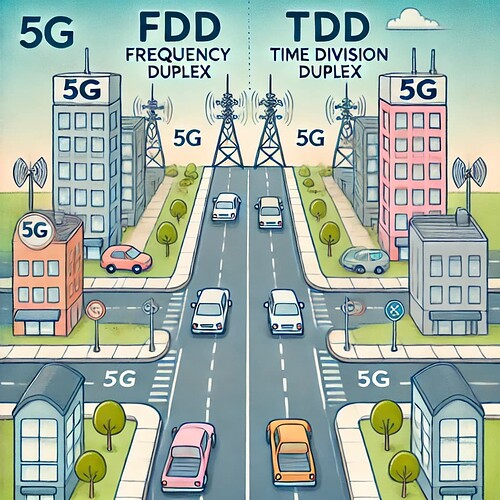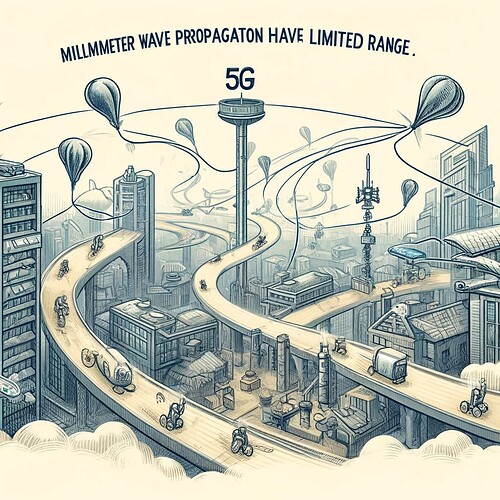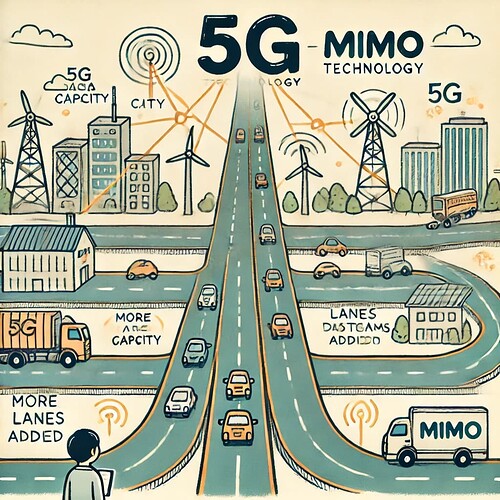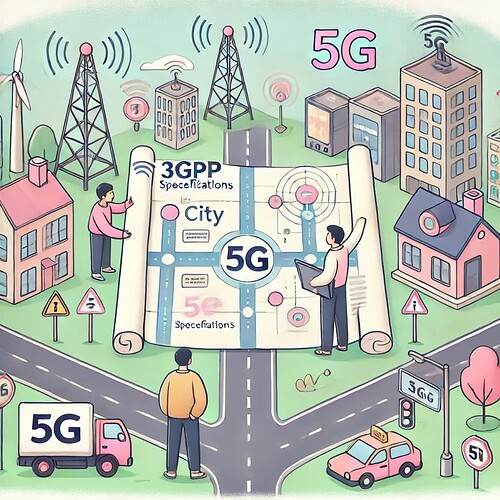This topic presents in a very simplified way all the main concepts that should be understood by those who know 5G NR.
5G NR Fundamentals
5G, the new generation of mobile networks introduced in the 3GPP’s Release 15, is designed to meet three key demands: ultra-fast mobile internet (eMBB), highly reliable, low-latency communications (URLLC), and massive device connectivity (mMTC). While 4G relies on LTE, 5G operates on a network called New Radio (NR), designed to work alongside 4G in a configuration called Non-Standalone (NSA), allowing for a gradual transition. A full 5G setup, or Standalone (SA), connects directly to a new 5G core network, maximizing the speed and efficiency benefits of this new technology. 5G base stations are highly flexible, enabling varied deployments and the use of advanced antennas for enhanced range and capacity. The network uses a broader frequency range to manage congestion and support the high speeds promised by 5G, while also employing advanced technologies like beamforming and MIMO to optimize connections and improve coverage, especially in dense areas. [In a Nutshell: 5G offers faster internet, reliable communication, and connectivity for many devices, using new technology for better performance and coverage.]
![]() *Imagine that 4G is like an old city where people travel on narrow roads and have small buildings. It works fine, but as more people move in, it gets crowded and slow. Now, 5G is like building a brand-new city with wide highways, fast trains, and tall buildings that fit a lot of people. This new city, 5G, has special roads for super-fast cars (for internet), roads for emergency vehicles that need no traffic (for urgent messages), and lots of parking spaces for all the devices people have. At first, people from the old city (4G) can use parts of the new city (5G), but over time, everyone will be able to move fully into the new city and enjoy all its benefits. 5G’s special highways and smart buildings make everything work faster, so nobody has to wait, even if the city gets really busy. [In a Nutshell analogy: 5G is like a modern city with wide, fast roads and plenty of space, designed to keep everything running smoothly as more people use it.]
*Imagine that 4G is like an old city where people travel on narrow roads and have small buildings. It works fine, but as more people move in, it gets crowded and slow. Now, 5G is like building a brand-new city with wide highways, fast trains, and tall buildings that fit a lot of people. This new city, 5G, has special roads for super-fast cars (for internet), roads for emergency vehicles that need no traffic (for urgent messages), and lots of parking spaces for all the devices people have. At first, people from the old city (4G) can use parts of the new city (5G), but over time, everyone will be able to move fully into the new city and enjoy all its benefits. 5G’s special highways and smart buildings make everything work faster, so nobody has to wait, even if the city gets really busy. [In a Nutshell analogy: 5G is like a modern city with wide, fast roads and plenty of space, designed to keep everything running smoothly as more people use it.]
Skip to: Roadmap to 5G NR
- 5G NR Introduction
- Use Cases
- Enhanced Mobile Broadband (eMBB)
- Massive Machine Type Communications (mMTC)
- Ultra Reliable and Low Latency Communications (URLLC)
- Vehicle to Everything (V2X)
- Requirements
- Network Architecture
- Reference Point System Architecture
- Service Based System Architecture
- Network Functions
- Base Station Architectures
- Standalone Base Station
- Non-Standalone Base Station
- CU-DU Split Base Station
- CP-UP Separation
- Antenna Architectures
- Base Station Classes
- Interfaces
- Xn Interface
- F1 Interface
- E1 Interface
- NG Interface
- X2 Interface
- Protocol Stacks
- User Plane
- Control Plane
- RRC States
- RRC Idle
- RRC Connected
- RRC Inactive
- Registration Management
- Connection Management
- Access Control
- Signalling Radio Bearers
- PDU Sessions
- Quality of Service
- Network Slicing
- Edge Computing
- MICO Mode
- UE Capabilities
- Spectrum
- Duplex Modes
- Operating Bands
- Band Combinations
- Millimeter Wave Propagation
- MIMO
- Beamforming
- 3GPP Specifications
5G NR Introduction
5G NR (New Radio) is the latest advancement in mobile network technology, surpassing LTE with faster speeds, greater capacity, and lower latency. Unlike LTE’s more limited flexibility, 5G NR is designed to support a broad range of applications and is highly scalable, allowing it to meet growing demands and future innovations. It operates across a wide range of frequencies, including both sub-6 GHz and millimeter waves, enabling robust performance and adaptability for diverse use cases. [In a Nutshell: 5G NR brings faster, more flexible, and scalable network capabilities than LTE, making it ready for current and future needs.]
![]() 5G NR (New Radio) is like a super futuristic city with roads that are much wider, smoother, and faster than those in the LTE city. These new, upgraded roads allow for many more cars (or data) to travel faster and reach their destination quicker and more reliably. [In a Nutshell analogy: 5G NR is like a high-tech city with smooth, fast roads that handle a lot more traffic efficiently.]
5G NR (New Radio) is like a super futuristic city with roads that are much wider, smoother, and faster than those in the LTE city. These new, upgraded roads allow for many more cars (or data) to travel faster and reach their destination quicker and more reliably. [In a Nutshell analogy: 5G NR is like a high-tech city with smooth, fast roads that handle a lot more traffic efficiently.]
- Search Forum
 5G NR Fundamentals
5G NR Fundamentals 
Use Cases
5G NR supports a broader range of use cases than LTE, covering Enhanced Mobile Broadband (eMBB), Massive Machine Type Communications (mMTC), and Ultra-Reliable Low-Latency Communications (URLLC). While LTE primarily focused on high-speed mobile broadband (eMBB), 5G expands its capabilities to meet the demands of IoT (mMTC) and critical low-latency applications (URLLC), such as autonomous driving, remote surgery, and industrial automation. This versatility allows 5G NR to address diverse and demanding scenarios, making it suitable for a wide variety of applications. [In a Nutshell: 5G NR can handle more types of applications than LTE, including IoT and critical real-time needs.]
![]() 5G is designed for all kinds of “people” or “vehicles” that need to travel around the city. Some need high-speed travel (for video streaming), some need to send lots of messages from tiny devices (like sensors), and others need super-fast response times (for things like remote-controlled machines). These different activities, or different ways people can use the network, are called use cases. [In a Nutshell analogy: 5G is like a city with special lanes for fast cars, messaging bikes, and quick-response vehicles to meet everyone’s needs.]
5G is designed for all kinds of “people” or “vehicles” that need to travel around the city. Some need high-speed travel (for video streaming), some need to send lots of messages from tiny devices (like sensors), and others need super-fast response times (for things like remote-controlled machines). These different activities, or different ways people can use the network, are called use cases. [In a Nutshell analogy: 5G is like a city with special lanes for fast cars, messaging bikes, and quick-response vehicles to meet everyone’s needs.]
- Search Forum
 5G NR Use Cases
5G NR Use Cases 
Enhanced Mobile Broadband (eMBB)
Enhanced Mobile Broadband (eMBB) in 5G NR delivers significantly faster data speeds and greater capacity than LTE, supporting bandwidth-intensive applications such as virtual/augmented reality and high-definition video streaming. While LTE offered mobile broadband, it lacked the spectrum range and advanced technologies like millimeter waves and massive MIMO that 5G NR employs, limiting its ability to provide the same high speeds and reliability. eMBB enables 5G to accommodate more users with consistently smooth, high-speed connections, especially in crowded areas, offering substantially higher peak data rates and improved user experiences compared to LTE. [In a Nutshell: eMBB in 5G NR provides faster, high-capacity connections, supporting data-heavy apps like VR and video streaming.]
![]() eMBB is like having super highways all over our city, meant for cars that want to go really fast and carry a lot of people or goods. This is great for things like video streaming or VR, which need a big road to get through without traffic jams. These highways let you download movies in seconds or have smooth video calls without any delays. [In a Nutshell analogy: eMBB in 5G gives us big, fast roads that handle lots of traffic, so data-heavy apps work smoothly without delays.]
eMBB is like having super highways all over our city, meant for cars that want to go really fast and carry a lot of people or goods. This is great for things like video streaming or VR, which need a big road to get through without traffic jams. These highways let you download movies in seconds or have smooth video calls without any delays. [In a Nutshell analogy: eMBB in 5G gives us big, fast roads that handle lots of traffic, so data-heavy apps work smoothly without delays.]
- Search Forum
 5G NR Enhanced Mobile Broadband (eMBB)
5G NR Enhanced Mobile Broadband (eMBB) 
Massive Machine Type Communications (mMTC)
Unlike LTE, which wasn’t optimized for large-scale IoT, 5G NR’s Massive Machine Type Communications (mMTC) supports billions of low-power devices across vast areas, enabling efficient IoT connectivity. This capability allows 5G NR to handle the exponential growth in connected devices and smart applications, making it ideal for smart cities, agriculture, and industrial automation. mMTC is specifically designed to connect a high density of IoT devices with low data rates and minimal power consumption, positioning 5G NR to support widespread IoT applications far more effectively than LTE. [In a Nutshell: mMTC in 5G connects billions of low-power devices efficiently, enabling smart city and industrial IoT applications.]
![]() mMTC is like having a ton of small roads for lots of tiny vehicles, like delivery robots or bikes. They don’t need a big lane, but they do need space to keep going all over the city without getting in the way of the big cars. Also, you can think of it as having millions of tiny sensors all over the city, each one sending small pieces of information to keep everything running smoothly, like in streetlights or smart fridges. [In a Nutshell analogy: mMTC in 5G creates small paths for tiny devices to communicate, keeping the city running smoothly with minimal power use.]
mMTC is like having a ton of small roads for lots of tiny vehicles, like delivery robots or bikes. They don’t need a big lane, but they do need space to keep going all over the city without getting in the way of the big cars. Also, you can think of it as having millions of tiny sensors all over the city, each one sending small pieces of information to keep everything running smoothly, like in streetlights or smart fridges. [In a Nutshell analogy: mMTC in 5G creates small paths for tiny devices to communicate, keeping the city running smoothly with minimal power use.]
- Search Forum
 5G NR Massive Machine Type Communications (mMTC)
5G NR Massive Machine Type Communications (mMTC) 
Ultra Reliable and Low Latency Communications (URLLC)
Ultra Reliable and Low Latency Communications (URLLC) in 5G NR provides extremely low latency and high reliability, a substantial advancement over LTE’s capabilities. While LTE could not meet the requirements of time-sensitive and mission-critical applications like autonomous vehicles, industrial automation, and remote healthcare, 5G NR’s URLLC was specifically designed to support these use cases, enabling real-time responsiveness. With significantly reduced latency and enhanced reliability, 5G NR is well-suited for applications that demand high precision and dependability. [In a Nutshell: URLLC in 5G NR provides ultra-reliable, low-latency connectivity for critical applications requiring instant responsiveness.]
![]() URLLC is like the city’s emergency lane, where special vehicles can zoom by instantly without stopping - super-fast and super-reliable emergency services. This is perfect for things that need to respond really quickly, like doctors operating machines from far away or self-driving cars that need to make instant decisions. URLLC means the network can send and receive important information very quickly. [In a Nutshell analogy: URLLC is like a super-fast emergency lane for critical data, allowing it to reach its destination instantly.]
URLLC is like the city’s emergency lane, where special vehicles can zoom by instantly without stopping - super-fast and super-reliable emergency services. This is perfect for things that need to respond really quickly, like doctors operating machines from far away or self-driving cars that need to make instant decisions. URLLC means the network can send and receive important information very quickly. [In a Nutshell analogy: URLLC is like a super-fast emergency lane for critical data, allowing it to reach its destination instantly.]
Vehicle to Everything (V2X)
While LTE could support basic vehicle communication, 5G NR enables advanced Vehicle-to-Everything (V2X) applications, which are critical for autonomous driving. 5G V2X capabilities surpass LTE by delivering faster, more reliable interactions among vehicles, infrastructure, and pedestrians, fostering safer and smarter transportation systems. V2X communication allows vehicles to exchange information with each other and with surrounding infrastructure, enhancing road safety and traffic efficiency. With 5G NR, V2X is supported by ultra-low latency and high reliability, essential for real-time responsiveness in transportation networks. [In a Nutshell: 5G NR’s V2X enables fast, reliable communication between vehicles, infrastructure, and people, enhancing safety and efficiency in transportation.]
![]() V2X is like setting up a system so every car, traffic light, and even pedestrians in the city can talk to each other, making the city super safe - cars that can talk to each other and to traffic lights. Cars can tell each other when they’re stopping, and streetlights can turn green just when they’re needed. This helps make driving safer and more efficient because vehicles can share information about road conditions and traffic. [In a Nutshell analogy: V2X makes it so everything on the road can communicate, helping cars and people stay safe and traffic flow smoothly.]
V2X is like setting up a system so every car, traffic light, and even pedestrians in the city can talk to each other, making the city super safe - cars that can talk to each other and to traffic lights. Cars can tell each other when they’re stopping, and streetlights can turn green just when they’re needed. This helps make driving safer and more efficient because vehicles can share information about road conditions and traffic. [In a Nutshell analogy: V2X makes it so everything on the road can communicate, helping cars and people stay safe and traffic flow smoothly.]
- Search Forum
 5G NR Vehicle to Everything (V2X)
5G NR Vehicle to Everything (V2X) 
Requirements
5G NR was developed to meet demanding requirements for data speed, latency, device density, and reliability, significantly surpassing LTE. While LTE primarily aimed to enhance mobile broadband speeds, 5G NR is designed to support a wide range of applications, ensuring consistent performance across diverse conditions and making it adaptable for both present and future needs. Key requirements for 5G NR include higher data rates, ultra-low latency, increased capacity, and enhanced energy efficiency. These goals are achieved through advanced technologies such as massive MIMO, beamforming, and the use of higher frequency bands. [In a Nutshell: 5G NR is built to meet high demands for speed, reliability, and capacity, adapting well to current and future applications.]
![]() 5G has special requirements, or “rules,” that make it run faster and handle more traffic than LTE. These rules are like the city’s building codes that ensure all the roads are wide enough and signals work perfectly for a smooth ride. Just like a city needs rules and regulations to function smoothly, 5G NR has certain requirements like high speed, reliability, and the ability to connect many devices at once. [In a Nutshell analogy: 5G’s special rules make sure it’s fast, reliable, and able to connect many devices, like building codes keep a city running smoothly.]
5G has special requirements, or “rules,” that make it run faster and handle more traffic than LTE. These rules are like the city’s building codes that ensure all the roads are wide enough and signals work perfectly for a smooth ride. Just like a city needs rules and regulations to function smoothly, 5G NR has certain requirements like high speed, reliability, and the ability to connect many devices at once. [In a Nutshell analogy: 5G’s special rules make sure it’s fast, reliable, and able to connect many devices, like building codes keep a city running smoothly.]
- Search Forum
 5G NR Requirements
5G NR Requirements 
Network Architecture
5G NR’s network architecture features a flexible and scalable design with two models: the Reference Point System Architecture and the Service-Based Architecture. This dual approach enables efficient distribution of network functions and adaptability to meet diverse use case requirements, allowing for quick reconfiguration as demand changes. The architecture comprises the core network and the radio access network (RAN), incorporating enhancements over LTE for improved performance and efficiency. [In a Nutshell: 5G NR’s flexible architecture allows it to quickly adapt and perform efficiently as demands evolve.]
![]() Network Architecture is like the overall map of the city that shows where everything is. 5G’s map is flexible and can be rearranged, unlike LTE’s fixed map, allowing it to change quickly when more people move in or new roads are built. [In a Nutshell analogy: 5G’s map is flexible, letting it adjust as the city grows or changes.]
Network Architecture is like the overall map of the city that shows where everything is. 5G’s map is flexible and can be rearranged, unlike LTE’s fixed map, allowing it to change quickly when more people move in or new roads are built. [In a Nutshell analogy: 5G’s map is flexible, letting it adjust as the city grows or changes.]
- Search Forum
 5G NR Network Architecture
5G NR Network Architecture 
Reference Point System Architecture
The Reference Point System Architecture in 5G NR uses predefined interfaces between network functions, similar to LTE, facilitating interoperability between LTE and 5G networks. However, 5G enhances this architecture to support higher data rates and new service requirements, enabling it to manage more complex traffic patterns beyond LTE’s capabilities. This architecture defines the interfaces and protocols within the 5G NR network, ensuring efficient communication and interoperability across various network components. [In a Nutshell: The Reference Point System Architecture in 5G allows for seamless communication between LTE and 5G, supporting faster data and more complex traffic needs.]
![]() The Reference Point System Architecture is like the fixed routes in the LTE city. 5G keeps these routes so it can still work well with LTE, making sure that even if people use LTE roads, they can still get around the 5G city smoothly. This is like having specific landmarks in the city that help guide the flow of data, ensuring it travels efficiently from one place to another. [In a Nutshell analogy: 5G keeps familiar routes from LTE so everyone can navigate the city easily, even with new buildings and faster roads.]
The Reference Point System Architecture is like the fixed routes in the LTE city. 5G keeps these routes so it can still work well with LTE, making sure that even if people use LTE roads, they can still get around the 5G city smoothly. This is like having specific landmarks in the city that help guide the flow of data, ensuring it travels efficiently from one place to another. [In a Nutshell analogy: 5G keeps familiar routes from LTE so everyone can navigate the city easily, even with new buildings and faster roads.]
- Search Forum
 5G NR Reference Point System Architecture
5G NR Reference Point System Architecture 
Service Based System Architecture
The Service-Based Architecture (SBA) in 5G NR enables direct communication between network functions, providing flexibility beyond LTE’s traditional architecture. This design enhances resource management and scalability, allowing 5G networks to support a wider range of complex, real-time applications. In SBA, network functions are implemented as services, allowing for more flexible and efficient network management, representing a significant improvement over LTE’s architecture. [In a Nutshell: SBA in 5G allows direct and flexible connections, making network management more efficient and adaptable than LTE.]
![]() SBA is like adding new, flexible streets that can connect to each other directly without needing fixed routes. This gives 5G city more ways to reach places, helping people travel faster and manage traffic better. In our 5G city, services like internet, phone calls, and messaging are provided in a flexible way. This architecture allows new services to be easily added or updated, like adding new features to a city. [In a Nutshell analogy: SBA lets new streets be added in 5G city, allowing faster, flexible travel and easy updates, like adding new buildings or services to a city.]
SBA is like adding new, flexible streets that can connect to each other directly without needing fixed routes. This gives 5G city more ways to reach places, helping people travel faster and manage traffic better. In our 5G city, services like internet, phone calls, and messaging are provided in a flexible way. This architecture allows new services to be easily added or updated, like adding new features to a city. [In a Nutshell analogy: SBA lets new streets be added in 5G city, allowing faster, flexible travel and easy updates, like adding new buildings or services to a city.]
- Search Forum
 5G NR Service Based System Architecture
5G NR Service Based System Architecture 
Network Functions
5G introduces a suite of Network Functions designed for scalability and efficiency, including the Access and Mobility Management Function (AMF), Session Management Function (SMF), and User Plane Function (UPF). These functions distribute tasks across the network, improving performance and adaptability compared to LTE’s more centralized structure, and enabling smoother data flow for users. In 5G NR, Network Functions cover both core and radio access network tasks, handling essential operations such as mobility management, session management, and data routing to optimize overall network efficiency. [In a Nutshell: 5G’s network functions divide tasks for improved efficiency and smoother data flow compared to LTE.]
![]() Network Functions in 5G are like different city services, such as traffic lights, toll booths, or road maintenance crews, each with a specific job. These services are spread across the city to keep everything running smoothly. Like the different departments in a city, each with its own job. Some handle data traffic, others manage connections, and some ensure security. [In a Nutshell analogy: 5G’s network functions work like city services, each handling specific tasks to keep everything running smoothly.]
Network Functions in 5G are like different city services, such as traffic lights, toll booths, or road maintenance crews, each with a specific job. These services are spread across the city to keep everything running smoothly. Like the different departments in a city, each with its own job. Some handle data traffic, others manage connections, and some ensure security. [In a Nutshell analogy: 5G’s network functions work like city services, each handling specific tasks to keep everything running smoothly.]
- Search Forum
 5G NR Network Functions
5G NR Network Functions 
Base Station Architectures
5G NR supports multiple base station configurations: Standalone (SA), Non-Standalone (NSA), and CU-DU split architecture. SA and NSA configurations facilitate gradual 5G deployment, while the CU-DU split architecture enhances efficiency and reduces latency, offering capabilities beyond LTE. These configurations make the 5G system more adaptable to various locations and data demands, providing deployment flexibility and improved network performance tailored to different operational needs. [In a Nutshell: 5G’s base station setups allow flexible deployment and high performance in diverse environments.]
![]() Base Station Architectures in 5G are like different types of power stations spread throughout the city to help send energy or signals where they’re needed. Some work with LTE, some are just for 5G, and some are shared between the two. Like cell towers in our 5G city, they come in different types and architectures, each designed to handle specific tasks and areas. [In a Nutshell analogy: Different 5G base stations are like power stations, each type serving its own purpose and location to keep the network running efficiently.]
Base Station Architectures in 5G are like different types of power stations spread throughout the city to help send energy or signals where they’re needed. Some work with LTE, some are just for 5G, and some are shared between the two. Like cell towers in our 5G city, they come in different types and architectures, each designed to handle specific tasks and areas. [In a Nutshell analogy: Different 5G base stations are like power stations, each type serving its own purpose and location to keep the network running efficiently.]
- Search Forum
 5G NR Base Station Architectures
5G NR Base Station Architectures 
Standalone Base Station
The Standalone (SA) base station in 5G NR operates independently on a 5G core network, offering complete 5G functionality. Unlike LTE’s single-function architecture, SA in 5G provides ultra-low latency and high-speed services without depending on legacy LTE infrastructure, fully maximizing 5G’s capabilities. This setup contrasts with Non-Standalone (NSA) base stations, which rely on LTE for certain functions. The SA architecture enables a more advanced, fully independent 5G experience, harnessing the full potential of 5G technology. [In a Nutshell: SA base stations bring full 5G benefits without needing LTE support.]
![]() A SA Base Station is like a power station built only for the 5G city. It’s fully independent, meaning it doesn’t rely on LTE at all, allowing 5G to have all the power and speed it needs on its own. You can also think of it as a self-sufficient building that can handle all the network tasks on its own without relying on other structures. [In a Nutshell: SA base stations are like self-sufficient power stations, built solely for 5G without needing any help from LTE.]
A SA Base Station is like a power station built only for the 5G city. It’s fully independent, meaning it doesn’t rely on LTE at all, allowing 5G to have all the power and speed it needs on its own. You can also think of it as a self-sufficient building that can handle all the network tasks on its own without relying on other structures. [In a Nutshell: SA base stations are like self-sufficient power stations, built solely for 5G without needing any help from LTE.]
- Search Forum
 5G NR Standalone Base Station
5G NR Standalone Base Station 
Non-Standalone Base Station
The Non-Standalone (NSA) base station in 5G NR utilizes existing LTE infrastructure to speed up 5G deployment. Unlike Standalone (SA) mode, which operates independently, NSA combines LTE and 5G resources, offering enhanced speeds over LTE while enabling operators to transition gradually to a fully 5G network. This approach allows for a faster, more cost-effective deployment of 5G services, making NSA an efficient solution for initial 5G rollout by leveraging the existing LTE foundation. [In a Nutshell: NSA base stations use LTE infrastructure to roll out 5G faster and at lower costs.]
![]() A NSA Base Station is a power station that works with both LTE and 5G, sharing its energy to help people move around while still letting 5G bring in extra power and speed. This type of base station works together with older 4G LTE towers, much like a new building that still uses some of the old city’s infrastructure. [In a Nutshell analogy: NSA base stations use old LTE infrastructure with 5G power, like a new building using some old city structures.]
A NSA Base Station is a power station that works with both LTE and 5G, sharing its energy to help people move around while still letting 5G bring in extra power and speed. This type of base station works together with older 4G LTE towers, much like a new building that still uses some of the old city’s infrastructure. [In a Nutshell analogy: NSA base stations use old LTE infrastructure with 5G power, like a new building using some old city structures.]
- Search Forum
 5G NR Non-Standalone Base Station
5G NR Non-Standalone Base Station 
CU-DU Split Base Station
5G NR’s CU-DU split architecture divides control and data processing into separate units, unlike LTE’s single-unit base station design. This separation, with a centralized control unit (CU) and a distributed unit (DU) closer to the user, allows for optimized data handling, improving efficiency and reducing latency beyond what LTE could achieve. The CU-DU split is especially beneficial in high-demand areas, enabling more flexible and efficient network management, which enhances overall performance and responsiveness. [In a Nutshell: The CU-DU split divides tasks to improve data processing efficiency and reduce latency, especially in busy areas.]
![]() A CU-DU Split Base Station separates the “thinking” part and the “action” part, like a traffic command center and street cameras. The command center makes decisions, and the cameras handle the traffic in real time to keep things moving. In this setup, the base station’s tasks are split between two parts: the Central Unit (CU) and the Distributed Unit (DU). It’s like having a main office and several branch offices working together. [In a Nutshell: CU-DU split means the thinking and action are separate, like a command center and its cameras.]
A CU-DU Split Base Station separates the “thinking” part and the “action” part, like a traffic command center and street cameras. The command center makes decisions, and the cameras handle the traffic in real time to keep things moving. In this setup, the base station’s tasks are split between two parts: the Central Unit (CU) and the Distributed Unit (DU). It’s like having a main office and several branch offices working together. [In a Nutshell: CU-DU split means the thinking and action are separate, like a command center and its cameras.]
- Search Forum
 5G NR CU-DU Split Base Station
5G NR CU-DU Split Base Station 
CP-UP Separation
Control Plane (CP) and User Plane (UP) separation in 5G NR enhances flexibility and resource management, allowing for more independent scaling compared to LTE’s combined CP-UP architecture. This separation optimizes network performance, especially in high-demand scenarios, by enabling independent scaling and fine-tuning of control and data traffic. As a result, 5G NR can handle data delivery more reliably and efficiently, making it well-suited for diverse and high-traffic environments. [In a Nutshell: CP-UP separation in 5G improves efficiency by managing control and data traffic separately, allowing better scaling and performance.]
![]() CP-UP Separation is like separating traffic lights from the actual cars on the road. Traffic lights direct the cars, but each moves on its own, making the system more efficient and less crowded. Like dividing the city’s traffic into two lanes: one for control signals (CP) and one for user data (UP). This helps manage the network more efficiently. [In a Nutshell: Separating signals and traffic makes everything run more smoothly, like separate lanes for traffic lights and cars.]
CP-UP Separation is like separating traffic lights from the actual cars on the road. Traffic lights direct the cars, but each moves on its own, making the system more efficient and less crowded. Like dividing the city’s traffic into two lanes: one for control signals (CP) and one for user data (UP). This helps manage the network more efficiently. [In a Nutshell: Separating signals and traffic makes everything run more smoothly, like separate lanes for traffic lights and cars.]
- Search Forum
 5G NR CP-UP Separation
5G NR CP-UP Separation 
Antenna Architectures
5G NR utilizes advanced antenna technologies like MIMO and beamforming to enhance coverage and data rates. These technologies enable multi-directional data streams and precise, targeted signal delivery, improving network efficiency and providing faster, more reliable connectivity, even at higher frequencies. This is particularly beneficial in high-traffic areas, where these antennas help maintain strong, consistent connections. [In a Nutshell: Advanced antennas in 5G boost coverage, data speed, and reliability, especially in crowded areas.]
![]() Antenna Architectures are like tall radio towers in the city that broadcast signals to help guide the traffic. In 5G, these antennas are smarter and can direct signals like flashlights, helping people get better service. Antenna architectures are like the different designs of antennas used in the city. These designs help improve signal strength and coverage. [In a Nutshell: Smart antennas in 5G act like flashlights, focusing signals to give stronger, better coverage.]
Antenna Architectures are like tall radio towers in the city that broadcast signals to help guide the traffic. In 5G, these antennas are smarter and can direct signals like flashlights, helping people get better service. Antenna architectures are like the different designs of antennas used in the city. These designs help improve signal strength and coverage. [In a Nutshell: Smart antennas in 5G act like flashlights, focusing signals to give stronger, better coverage.]
- Search Forum
 5G NR Antenna Architectures
5G NR Antenna Architectures 
Base Station Classes
While LTE primarily relied on macro cells, 5G NR introduces a variety of base station types, including macro, small, and millimeter-wave cells, each tailored to different environments. This diversity allows 5G NR to deliver both extensive coverage and high-speed connectivity, optimized for specific geographic and user requirements, ensuring consistent service across urban and rural areas. In 5G NR, base stations are classified by their power levels and coverage areas, ranging from small cells with limited range to larger macro cells, effectively supporting a wide range of deployment scenarios. [In a Nutshell: 5G NR’s varied base stations offer flexible, reliable coverage tailored to both cities and rural areas.]
![]() Base Station Classes are like different types of traffic hubs, from big stations for the whole city to smaller stations for neighborhoods. This setup helps balance traffic better and gives better access in crowded places. Base station classes are like different types of buildings in the city, each designed for specific purposes, such as residential, commercial, or industrial use. [In a Nutshell: 5G has big and small stations, like city hubs, to manage different areas and needs efficiently.]
Base Station Classes are like different types of traffic hubs, from big stations for the whole city to smaller stations for neighborhoods. This setup helps balance traffic better and gives better access in crowded places. Base station classes are like different types of buildings in the city, each designed for specific purposes, such as residential, commercial, or industrial use. [In a Nutshell: 5G has big and small stations, like city hubs, to manage different areas and needs efficiently.]
- Search Forum
 5G NR Base Station Classes
5G NR Base Station Classes 
Interfaces
The 5G NR architecture incorporates multiple interfaces, including Xn, F1, E1, and NG, to facilitate seamless communication across network functions. Each interface manages crucial processes such as handovers, session management, and data transport, ensuring a smooth user experience as users move throughout the network. These interfaces work together to support 5G’s high-speed, low-latency performance, enabling efficient coordination and connectivity across the network infrastructure. [In a Nutshell: 5G interfaces work together to ensure smooth and fast data flow across the network, enhancing the user experience.]
![]() Interfaces are like roads and bridges that connect different parts of the city, each with a specific role. They let different parts of the city talk to each other so everything works together smoothly - allowing data to travel between various network components. [In a Nutshell: 5G interfaces are like roads in a city, connecting everything to keep data moving smoothly.]
Interfaces are like roads and bridges that connect different parts of the city, each with a specific role. They let different parts of the city talk to each other so everything works together smoothly - allowing data to travel between various network components. [In a Nutshell: 5G interfaces are like roads in a city, connecting everything to keep data moving smoothly.]
- Search Forum
 5G NR Interfaces
5G NR Interfaces 
Xn Interface
The Xn Interface in 5G NR, an evolution of LTE’s X2 interface, connects base stations (gNodeBs) to support efficient handovers and load balancing. Optimized for 5G’s higher speeds and low latency, the Xn interface ensures continuous connectivity for mobile users, particularly during high-speed travel - capabilities that LTE couldn’t fully support. By linking neighboring gNodeBs, the Xn interface enables coordination within the 5G NR network, allowing for smooth handovers and enhanced network efficiency. [In a Nutshell: The Xn Interface enables smooth connectivity transitions between 5G base stations, even at high speeds, ensuring a seamless user experience.]
![]() The Xn Interface is like a main road between 5G stations, letting them share traffic information and help people move from one area to another without getting stuck. Like a highway that connects different parts of the 5G network, allowing data to move quickly and efficiently. [In a Nutshell: The Xn Interface is like a main road between stations, allowing data to flow smoothly and keeping everything connected.]
The Xn Interface is like a main road between 5G stations, letting them share traffic information and help people move from one area to another without getting stuck. Like a highway that connects different parts of the 5G network, allowing data to move quickly and efficiently. [In a Nutshell: The Xn Interface is like a main road between stations, allowing data to flow smoothly and keeping everything connected.]
- Search Forum
 5G NR Xn Interface
5G NR Xn Interface 
F1 Interface
The F1 Interface in 5G NR connects the Centralized Unit (CU) and Distributed Unit (DU), enabling a split base station architecture that LTE didn’t have. This interface supports flexible deployments and brings processing closer to the user, resulting in lower latency and better performance, especially in high-traffic locations. [In a Nutshell: The F1 Interface links the CU and DU, enhancing flexibility and performance by reducing latency, particularly in busy areas.]
![]() The F1 Interface is like a road connecting the traffic command center with neighborhood cameras, allowing better control over how traffic is managed at a local level. It connects the CU and DU in a split base station, enabling flexible deployment. [In a Nutshell: The F1 Interface is like a road connecting central and local controls, improving how traffic is handled in each neighborhood.]
The F1 Interface is like a road connecting the traffic command center with neighborhood cameras, allowing better control over how traffic is managed at a local level. It connects the CU and DU in a split base station, enabling flexible deployment. [In a Nutshell: The F1 Interface is like a road connecting central and local controls, improving how traffic is handled in each neighborhood.]
- Search Forum
 5G NR F1 Interface
5G NR F1 Interface 
E1 Interface
The E1 Interface in 5G NR facilitates communication between core network functions, similar to certain LTE interfaces but with improved data handling and signaling capabilities. This enhancement enables 5G NR to manage complex interactions more efficiently, supporting high-speed, low-latency applications for an optimized user experience. The E1 interface links various network functions within the 5G core, aligning with its service-based architecture and contributing to the flexible, scalable structure of 5G NR. [In a Nutshell: The E1 Interface improves communication within the 5G core, enhancing performance and scalability.]
![]() The E1 Interface is like a hotline connecting city departments, allowing them to coordinate and make sure everything runs smoothly, like handling city maintenance and emergency response. [In a Nutshell: The E1 Interface is like a hotline that keeps city departments in sync, ensuring efficient coordination.]
The E1 Interface is like a hotline connecting city departments, allowing them to coordinate and make sure everything runs smoothly, like handling city maintenance and emergency response. [In a Nutshell: The E1 Interface is like a hotline that keeps city departments in sync, ensuring efficient coordination.]
- Search Forum
 5G NR E1 Interface
5G NR E1 Interface 
NG Interface
The NG Interface in 5G NR connects the radio access network (gNodeB) to the 5G core network, similar to LTE’s S1 interface but optimized for 5G’s higher data demands. This interface provides faster and more reliable connections, enhancing the user experience in dynamic environments. By linking the gNodeB to the 5G core, the NG interface enables seamless communication between the radio access network and the core network, supporting 5G’s high-speed, low-latency performance requirements. [In a Nutshell: The NG Interface links the gNodeB with the 5G core, optimizing connectivity and performance.]
![]() The NG Interface is like a superhighway that connects the outer parts of the city to its core. This road allows fast travel between base stations and the city center, keeping traffic flowing smoothly. The NG interface connects the base station (gNodeB) to the 5G core network. [In a Nutshell: The NG Interface is a high-speed route connecting outer areas to the city center for efficient traffic flow.]
The NG Interface is like a superhighway that connects the outer parts of the city to its core. This road allows fast travel between base stations and the city center, keeping traffic flowing smoothly. The NG interface connects the base station (gNodeB) to the 5G core network. [In a Nutshell: The NG Interface is a high-speed route connecting outer areas to the city center for efficient traffic flow.]
- Search Forum
 5G NR NG Interface
5G NR NG Interface 
X2 Interface
In Non-Standalone (NSA) 5G, the X2 interface enables interoperability between LTE and 5G NR cells, allowing seamless handovers between them to ensure continuity of service - an essential feature for gradual 5G deployment. Like in LTE, the X2 interface in 5G NR connects eNodeBs (LTE base stations) and gNodeBs (5G base stations), supporting efficient handovers and coordination between different base stations. This interface allows for smooth transitions between LTE and 5G NR, which was unnecessary in LTE’s single-mode environment. [In a Nutshell: The X2 interface links LTE and 5G NR, allowing seamless handovers and continuity between them.]
![]() The X2 Interface connects LTE city with 5G city, acting like a bridge that lets people use both types of roads to reach their destination, making sure no one gets lost. [In a Nutshell: The X2 Interface is a bridge connecting LTE and 5G for smooth, uninterrupted travel.]
The X2 Interface connects LTE city with 5G city, acting like a bridge that lets people use both types of roads to reach their destination, making sure no one gets lost. [In a Nutshell: The X2 Interface is a bridge connecting LTE and 5G for smooth, uninterrupted travel.]
- Search Forum
 5G NR X2 Interface
5G NR X2 Interface 
Protocol Stacks
In 5G NR, protocol stacks are sets of layered protocols that manage communication between the user equipment (UE) and the network, organized into User Plane and Control Plane stacks to handle data transfer and signaling, respectively. These stacks include layers such as PDCP, RLC, and MAC, optimized for 5G’s high-speed, low-latency requirements, enabling efficient data handling and control with faster processing than LTE. A new layer, the Service Data Adaptation Protocol (SDAP), is introduced in 5G NR to map Quality of Service (QoS) flows to data radio bearers, enhancing QoS management. The protocol stack covers different transmission aspects, including the physical, data link, network, and application layers. Compared to LTE, 5G NR protocol stacks are designed to support higher data rates, lower latency, and more efficient spectrum usage. [In a Nutshell: 5G NR protocol stacks are optimized for fast, efficient communication, with added layers to handle advanced QoS and high data rates.]
![]() Protocol Stacks in 5G are like layers in a sandwich, each with a job, from handling messages to controlling traffic signals. These layers make sure data travels without delays or mix-ups, managing different aspects of data transfer and signaling. [In a Nutshell: Protocol stacks are layered to ensure smooth, fast data movement, like ingredients in a sandwich each doing a job.]
Protocol Stacks in 5G are like layers in a sandwich, each with a job, from handling messages to controlling traffic signals. These layers make sure data travels without delays or mix-ups, managing different aspects of data transfer and signaling. [In a Nutshell: Protocol stacks are layered to ensure smooth, fast data movement, like ingredients in a sandwich each doing a job.]
- Search Forum
 5G NR Protocol Stacks
5G NR Protocol Stacks 
User Plane
The User Plane in 5G NR handles the transfer of user data traffic, facilitating the flow of data packets between devices and the core network. It comprises layers such as SDAP, PDCP, RLC, and MAC, each optimized to support high data rates and low latency, ensuring a fast and reliable data experience essential for modern applications. Compared to LTE, the 5G NR User Plane is optimized for higher throughput and lower latency, enabling faster, more dependable data services. [In a Nutshell: The 5G User Plane ensures quick, reliable data flow between devices and the network.]
![]() The User Plane is like the actual road on which cars drive, carrying data (or passengers) back and forth across the city. It’s faster and more spacious than the roads in LTE. User Plane: The user plane handles the actual data transfer between users and the network, ensuring efficient communication. [In a Nutshell: The User Plane is the main road that quickly and efficiently carries data back and forth.]
The User Plane is like the actual road on which cars drive, carrying data (or passengers) back and forth across the city. It’s faster and more spacious than the roads in LTE. User Plane: The user plane handles the actual data transfer between users and the network, ensuring efficient communication. [In a Nutshell: The User Plane is the main road that quickly and efficiently carries data back and forth.]
- Search Forum
 5G NR User Plane
5G NR User Plane 
Control Plane
The Control Plane in 5G NR manages essential network signaling, mobility, and session control, handling tasks such as registration, connection, and session management. This ensures devices remain connected, authenticated, and capable of moving seamlessly across the network, with more robust support for fast and stable connections than LTE. The Control Plane manages signaling and control information between the UE and the network through protocols like Radio Resource Control (RRC) and Non-Access Stratum (NAS). In 5G NR, it is specifically designed to accommodate more complex signaling requirements and supports advanced features like network slicing and edge computing, which are not present in LTE. [In a Nutshell: The Control Plane in 5G ensures smooth, secure connectivity and movement for devices, managing all control-related data flows between devices and the network.]
![]() The Control Plane is like the city’s traffic command center, handling everything that guides, manages, and organizes how and when data moves, just like traffic lights and road signs. [In a Nutshell: The Control Plane is the command center that keeps data moving smoothly and safely, like traffic lights and signs in a city.]
The Control Plane is like the city’s traffic command center, handling everything that guides, manages, and organizes how and when data moves, just like traffic lights and road signs. [In a Nutshell: The Control Plane is the command center that keeps data moving smoothly and safely, like traffic lights and signs in a city.]
- Search Forum
 5G NR Control Plane
5G NR Control Plane 
RRC States
5G NR includes three main Radio Resource Control (RRC) states: RRC Idle, RRC Connected, and RRC Inactive. These states facilitate efficient network connectivity, optimizing battery life while ensuring devices remain reachable or active when necessary - offering flexibility beyond LTE. These states manage the UE’s connection to the network, balancing power consumption and resource allocation. Unlike LTE, 5G NR introduces the RRC Inactive state, enabling faster transitions between idle and connected states, which improves efficiency and reduces latency. [In a Nutshell: 5G’s RRC states balance connectivity and power use, allowing quick reconnections while conserving battery.]
![]() RRC States are like different modes your car can be in - parked, moving, or resting temporarily. Each mode helps the network know if a device needs full power, a break, or quick access. [In a Nutshell: RRC states are like car modes, helping devices save power or access data quickly as needed.]
RRC States are like different modes your car can be in - parked, moving, or resting temporarily. Each mode helps the network know if a device needs full power, a break, or quick access. [In a Nutshell: RRC states are like car modes, helping devices save power or access data quickly as needed.]
- Search Forum
 5G NR RRC States
5G NR RRC States 
RRC Idle
RRC Idle mode conserves battery by disconnecting the device from active communication while keeping its registration with the network. This state allows devices to save power when no data transfer is required, but they can quickly reconnect when needed, helping to extend battery life. In RRC Idle, the UE is not actively communicating but can still receive paging messages and perform cell reselection. While LTE also has an idle state, 5G NR enhances it with more efficient paging and cell reselection mechanisms, further optimizing battery conservation and reconnection speed. [In a Nutshell: RRC Idle helps devices save power while staying ready for quick reconnections.]
![]() RRC Idle is like parking your car, where your device isn’t actively using data, but is ready to move when needed. This saves power until there’s a need for data. In the RRC Idle state, devices are like cars parked at the side of the road, ready to drive off quickly when needed. They aren’t actively moving data but can jump into action as soon as they’re required. [In a Nutshell: RRC Idle is like parked cars, saving energy but ready to drive when needed.]
RRC Idle is like parking your car, where your device isn’t actively using data, but is ready to move when needed. This saves power until there’s a need for data. In the RRC Idle state, devices are like cars parked at the side of the road, ready to drive off quickly when needed. They aren’t actively moving data but can jump into action as soon as they’re required. [In a Nutshell: RRC Idle is like parked cars, saving energy but ready to drive when needed.]
- Search Forum
 5G NR RRC Idle
5G NR RRC Idle 
RRC Connected
RRC Connected mode keeps the device actively linked to the network, enabling continuous data transfer, signaling, and low-latency interactions. This state is used when the device requires an active data session, supporting high-speed applications like streaming and gaming to ensure uninterrupted data flow. While similar in both LTE and 5G NR, 5G NR enhances this mode with higher data rates and more efficient resource management, delivering improved performance overall. [In a Nutshell: RRC Connected keeps devices actively connected, supporting high-speed data flow and applications.]
![]() RRC Connected is like driving in the city with full speed and access to every road. This state allows full data usage and ensures everything is active for fast connections. Devices are like cars actively driving on the roads, continuously communicating with traffic lights and other vehicles to ensure smooth travel and data exchange. [In a Nutshell: RRC Connected is like actively driving with open access to all roads for smooth, fast connections.]
RRC Connected is like driving in the city with full speed and access to every road. This state allows full data usage and ensures everything is active for fast connections. Devices are like cars actively driving on the roads, continuously communicating with traffic lights and other vehicles to ensure smooth travel and data exchange. [In a Nutshell: RRC Connected is like actively driving with open access to all roads for smooth, fast connections.]
- Search Forum
 5G NR RRC Connected
5G NR RRC Connected 
RRC Inactive
Unique to 5G NR, the RRC Inactive state preserves network context without requiring continuous connectivity, a feature not available in LTE. This state conserves battery life while keeping devices reachable for rapid reconnection, making it ideal for intermittent data use. It allows the UE to quickly switch between idle and connected states without needing full re-establishment procedures, reducing signaling overhead and improving latency, which makes it significantly more efficient than LTE’s approach. [In a Nutshell: RRC Inactive conserves battery while keeping devices ready for quick reconnection.]
![]() RRC Inactive is like idling your car at a red light, where you’re ready to move quickly without fully stopping. This state lets devices save energy but stay ready for a quick start. RRC Inactive is a new state in 5G NR that’s like cars in a rest area, ready to switch to active driving mode at a moment’s notice. This reduces the delay in getting back on the road and improves overall traffic flow and efficiency. [In a Nutshell: RRC Inactive keeps devices ready for quick use, conserving energy like cars idling, waiting to drive again at any moment.]
RRC Inactive is like idling your car at a red light, where you’re ready to move quickly without fully stopping. This state lets devices save energy but stay ready for a quick start. RRC Inactive is a new state in 5G NR that’s like cars in a rest area, ready to switch to active driving mode at a moment’s notice. This reduces the delay in getting back on the road and improves overall traffic flow and efficiency. [In a Nutshell: RRC Inactive keeps devices ready for quick use, conserving energy like cars idling, waiting to drive again at any moment.]
- Search Forum
 5G NR RRC Inactive
5G NR RRC Inactive 
Registration Management
5G NR enhances Registration Management by efficiently tracking device locations with fewer updates, an improvement over LTE’s approach. While LTE’s registration management was effective, 5G NR conserves network resources and maintains connectivity more efficiently, particularly in high-density areas. This process involves procedures for the UE to register with the network, ensuring service access and connectivity, and includes initial registration, periodic updates, and deregistration. Compared to LTE, 5G NR registration management supports advanced features such as network slicing and enhanced security, optimizing resource use and providing a more secure, responsive network experience. [In a Nutshell: 5G NR improves registration management, conserving resources and enhancing security, especially in crowded areas.]
![]() Registration Management is like getting a city pass, so the city always knows where you are and can guide you as you move around, saving time and making sure you’re never lost. You can also think of it as getting a library card. It’s the process of signing up to use the library (network), ensuring that your details are registered so you can borrow books (access services) whenever you need. [In a Nutshell: Registration is like getting a pass so the city can help you get around easily without getting lost.]
Registration Management is like getting a city pass, so the city always knows where you are and can guide you as you move around, saving time and making sure you’re never lost. You can also think of it as getting a library card. It’s the process of signing up to use the library (network), ensuring that your details are registered so you can borrow books (access services) whenever you need. [In a Nutshell: Registration is like getting a pass so the city can help you get around easily without getting lost.]
- Search Forum
 5G NR Registration Management
5G NR Registration Management 
Connection Management
Connection Management in 5G NR ensures stable data sessions with greater flexibility than LTE, meeting 5G’s low-latency and high-speed demands. It manages the establishment, maintenance, and release of connections between user equipment (UE) and the network, handling both signaling connections and data sessions. This enhanced capability supports faster setup times and more efficient resource allocation, providing seamless data experiences for diverse applications and improving data flow for high-demand applications. 5G NR’s advanced connection management thus enables more efficient and responsive connections compared to LTE. [In a Nutshell: 5G NR offers stable, flexible, and fast connection management, enhancing data flow and efficiency over LTE.]
![]() Connection Management is like reserving your route in advance, so when you need to go somewhere, the city knows and makes sure you have a clear road. You can also think of it as the library’s system for checking books in and out. It handles the process of borrowing a book (establishing a connection), keeping it for a while (maintenance), and then returning it (termination). [In a Nutshell: Connection management ensures you have a reserved route or a system for borrowing and returning items smoothly.]
Connection Management is like reserving your route in advance, so when you need to go somewhere, the city knows and makes sure you have a clear road. You can also think of it as the library’s system for checking books in and out. It handles the process of borrowing a book (establishing a connection), keeping it for a while (maintenance), and then returning it (termination). [In a Nutshell: Connection management ensures you have a reserved route or a system for borrowing and returning items smoothly.]
- Search Forum
 5G NR Connection Management
5G NR Connection Management 
Access Control
Access Control in 5G NR regulates network access with enhanced security and prioritization compared to LTE. It manages entry permissions by prioritizing devices based on authorization levels and service requirements, improving network security and resource allocation, especially for critical applications. This access control ensures that only authorized user equipment (UE) can connect to the network and access services, employing stronger encryption and robust security mechanisms for authentication and authorization. These advancements make 5G NR’s access control more secure and efficient than LTE. [In a Nutshell: 5G NR enhances access control by prioritizing devices based on security and service needs, ensuring only authorized devices connect.]
![]() Access Control is like having entry checkpoints in the city. It checks who is allowed in certain areas, keeping the city safe and giving priority access when needed. You can also think of it as the librarian making sure only people with a library card can borrow books. It ensures that only authorized users can access the network, keeping it secure and orderly. [In a Nutshell analogy: Access control acts like checkpoints or library cards, ensuring secure and organized access.]
Access Control is like having entry checkpoints in the city. It checks who is allowed in certain areas, keeping the city safe and giving priority access when needed. You can also think of it as the librarian making sure only people with a library card can borrow books. It ensures that only authorized users can access the network, keeping it secure and orderly. [In a Nutshell analogy: Access control acts like checkpoints or library cards, ensuring secure and organized access.]
- Search Forum
 5G NR Access Control
5G NR Access Control 
Signalling Radio Bearers
5G NR’s Signaling Radio Bearers (SRBs) efficiently carry control information, offering enhanced capabilities over LTE. SRBs manage control signaling between the user equipment (UE) and the network, ensuring reliable communication by separating control data from user data. This separation enables 5G NR to handle complex signaling requirements more effectively, keeping the network organized and responsive. With improved efficiency, 5G NR’s SRBs reduce latency and enhance overall performance compared to LTE. [In a Nutshell: 5G NR SRBs separate control and user data, boosting efficiency, reducing latency, and enhancing performance.]
![]() SRBs are like the postal service trucks that carry important messages, keeping all parts of the city informed and connected. You can also think of it as dedicated paths in the library where you walk to get your books. They are logical channels used to carry control and signaling messages between your device and the network, ensuring you get the right book from the right shelf without getting lost. [In a Nutshell: SRBs are like postal trucks or library paths, ensuring efficient message delivery and organization.]
SRBs are like the postal service trucks that carry important messages, keeping all parts of the city informed and connected. You can also think of it as dedicated paths in the library where you walk to get your books. They are logical channels used to carry control and signaling messages between your device and the network, ensuring you get the right book from the right shelf without getting lost. [In a Nutshell: SRBs are like postal trucks or library paths, ensuring efficient message delivery and organization.]
- Search Forum
 5G NR Signalling Radio Bearers
5G NR Signalling Radio Bearers 
PDU Sessions
5G NR Protocol Data Unit (PDU) Sessions manage user data transfer with greater flexibility than LTE’s bearer structure, supporting multiple Quality of Service (QoS) levels to meet varied application needs. Unlike LTE’s limited bearer capabilities, 5G NR’s PDU Sessions allow the network to handle diverse data demands efficiently, enhancing service quality per application. These sessions manage data traffic between the user equipment (UE) and the network, overseeing the encapsulation and transmission of data packets. 5G NR also supports multiple PDU session types, including IP and non-IP, offering greater flexibility and efficiency than LTE. [In a Nutshell: 5G NR PDU Sessions improve data transfer flexibility and QoS, efficiently handling diverse data needs across applications.]
![]() PDU Sessions are like renting a lane on the highway just for you, ensuring your data travels smoothly without interruptions, like a special VIP lane. You can also think of it as delivery trucks in our city. They manage how packages (data) are sent between houses (devices) and the central warehouse (network). These trucks handle all kinds of deliveries, ensuring everything gets to the right place efficiently. [In a Nutshell analogy: PDU Sessions are like a VIP lane or dedicated delivery trucks, ensuring smooth and efficient data transfer.]
PDU Sessions are like renting a lane on the highway just for you, ensuring your data travels smoothly without interruptions, like a special VIP lane. You can also think of it as delivery trucks in our city. They manage how packages (data) are sent between houses (devices) and the central warehouse (network). These trucks handle all kinds of deliveries, ensuring everything gets to the right place efficiently. [In a Nutshell analogy: PDU Sessions are like a VIP lane or dedicated delivery trucks, ensuring smooth and efficient data transfer.]
- Search Forum
 5G NR PDU Sessions
5G NR PDU Sessions 
Quality of Service
5G NR offers more granular Quality of Service (QoS) controls than LTE, ensuring consistent performance across a wider range of applications. With advanced QoS prioritization, 5G NR is better equipped to support low-latency and high-speed services, delivering reliable performance even for critical applications by adapting to the specific needs of each application. QoS in 5G NR manages aspects such as latency, throughput, and reliability for different types of traffic, ensuring each receives the necessary priority and resources. This more refined and dynamic QoS management enables 5G to better support diverse use cases compared to LTE. [In a Nutshell: 5G NR’s advanced QoS provides reliable, priority-based performance across varied applications, enhancing efficiency over LTE.]
![]() Quality of Service is like the city giving priority roads to ambulances, buses, and other critical services, ensuring they move faster and are always on time. Like the traffic control system in our city, it makes sure that emergency vehicles (critical applications) get green lights and clear roads first, while other vehicles (less critical traffic) might wait a bit, ensuring the most important deliveries are always on time. [In a Nutshell analogy: QoS prioritizes critical services, like green lights for ambulances, to ensure the most essential data always gets through quickly.]
Quality of Service is like the city giving priority roads to ambulances, buses, and other critical services, ensuring they move faster and are always on time. Like the traffic control system in our city, it makes sure that emergency vehicles (critical applications) get green lights and clear roads first, while other vehicles (less critical traffic) might wait a bit, ensuring the most important deliveries are always on time. [In a Nutshell analogy: QoS prioritizes critical services, like green lights for ambulances, to ensure the most essential data always gets through quickly.]
- Search Forum
 5G NR Quality of Service
5G NR Quality of Service 
Network Slicing
Network Slicing in 5G NR enables the creation of virtual network segments, each optimized for specific applications - a feature not available in LTE. With Network Slicing, multiple virtual networks can operate on the same physical 5G infrastructure, each with dedicated resources to meet the performance needs of different use cases, such as IoT, enhanced mobile broadband, and mission-critical applications. This approach ensures seamless multi-service operation, as each slice is tailored to the specific requirements of its application, ensuring efficient and optimized performance. Unlike LTE, 5G NR can create and manage these slices dynamically, offering far greater flexibility and adaptability for diverse network demands. [In a Nutshell: Network Slicing allows 5G to support multiple virtual networks, each tailored to specific needs, providing flexibility and efficient resource use.]
![]() Network Slicing is like having separate roads for trucks, cars, and bikes. Each slice is made just for specific types of traffic, so everyone can get where they’re going without interference. Like building different types of roads for different vehicles in our city, this way, each type of traffic gets its own dedicated path, ensuring smooth travel without interference from others. [In a Nutshell analogy: Network Slicing provides separate paths for different types of traffic, keeping everything organized and efficient.]
Network Slicing is like having separate roads for trucks, cars, and bikes. Each slice is made just for specific types of traffic, so everyone can get where they’re going without interference. Like building different types of roads for different vehicles in our city, this way, each type of traffic gets its own dedicated path, ensuring smooth travel without interference from others. [In a Nutshell analogy: Network Slicing provides separate paths for different types of traffic, keeping everything organized and efficient.]
- Search Forum
 5G NR Network Slicing
5G NR Network Slicing 
Edge Computing
5G NR introduces Edge Computing, which processes data closer to users, significantly reducing latency and improving response times compared to LTE. While LTE networks rely more on centralized processing, 5G’s Edge Computing allows for local data processing and storage, bringing it closer to the user. This setup is crucial for real-time applications like augmented reality, autonomous vehicles, and online gaming, as it minimizes data travel distance and speeds up response times. Although LTE supports some level of edge computing, 5G greatly expands its capabilities, offering faster and more efficient performance for applications that require immediate processing and low latency. [In a Nutshell: 5G’s Edge Computing brings data processing closer to users, reducing latency and boosting speed for real-time applications.]
![]() Edge Computing is like having mini control centers in every neighborhood, so decisions can be made quickly without needing to check in with the main city command center. You can also think of it as having small grocery stores in each neighborhood instead of one big supermarket far away. It means data (groceries) doesn’t have to travel far to get to users, making everything faster and more efficient. [In a Nutshell: Edge Computing puts data centers close to users, and speeds up City responses by keeping data processing close to where it’s needed.]
Edge Computing is like having mini control centers in every neighborhood, so decisions can be made quickly without needing to check in with the main city command center. You can also think of it as having small grocery stores in each neighborhood instead of one big supermarket far away. It means data (groceries) doesn’t have to travel far to get to users, making everything faster and more efficient. [In a Nutshell: Edge Computing puts data centers close to users, and speeds up City responses by keeping data processing close to where it’s needed.]
- Search Forum
 5G NR Edge Computing
5G NR Edge Computing 
MICO Mode
Mobile Initiated Connection Only (MICO) mode in 5G NR enhances battery life by reducing unnecessary network interactions, a level of optimization that LTE could not achieve. MICO mode is especially useful for devices with intermittent connectivity requirements, enabling more efficient power management by allowing devices to remain in a low-power state and only wake up when necessary to transmit data. This reduces both the signaling load on the network and power consumption during idle times, thereby extending battery life and alleviating network congestion. LTE lacks an equivalent mode with the same level of efficiency for power management and network optimization. [In a Nutshell: MICO mode saves battery by reducing network interactions and only waking devices when needed, improving power management compared to LTE.]
![]() MICO Mode is like a sleep mode for devices, saving power when they don’t need the network but allowing them to connect again when needed without much delay. It is like having streetlights that stay off to save energy but light up only when cars pass by. This helps reduce unnecessary work for the network by allowing devices to stay in low-power mode and wake up only when they need to send data. [In a Nutshell: MICO Mode saves energy by letting devices sleep and only wake up when they need to connect, like motion-sensor lights.]
MICO Mode is like a sleep mode for devices, saving power when they don’t need the network but allowing them to connect again when needed without much delay. It is like having streetlights that stay off to save energy but light up only when cars pass by. This helps reduce unnecessary work for the network by allowing devices to stay in low-power mode and wake up only when they need to send data. [In a Nutshell: MICO Mode saves energy by letting devices sleep and only wake up when they need to connect, like motion-sensor lights.]
- Search Forum
 5G NR MICO Mode
5G NR MICO Mode 
UE Capabilities
UE (User Equipment) capabilities in 5G NR encompass a broader range of advanced features, such as support for higher frequencies, MIMO, and beamforming, surpassing what LTE devices could handle. These expanded capabilities allow 5G devices to connect more efficiently to networks, achieving faster speeds and more reliable connectivity, which are essential for advanced 5G applications. UE capabilities in 5G refer to the various features and functionalities that 5G devices can support, including multi-band usage, high data rates, and advanced antenna technologies like MIMO. [In a Nutshell: 5G UE capabilities offer advanced features, ensuring efficient connections and high performance.]
![]() UE Capabilities are like knowing the type of vehicle you’re driving - whether it’s a bike, car, or truck - each with different needs and able to handle different types of roads and speeds. Some vehicles can use different types of fuel (frequency bands), have advanced navigation systems (MIMO capabilities), and can go really fast (maximum data rates). These features help devices perform better in the network. [In a Nutshell analogy: UE capabilities in 5G are like specialized vehicles on the road, each optimized for different network needs.]
UE Capabilities are like knowing the type of vehicle you’re driving - whether it’s a bike, car, or truck - each with different needs and able to handle different types of roads and speeds. Some vehicles can use different types of fuel (frequency bands), have advanced navigation systems (MIMO capabilities), and can go really fast (maximum data rates). These features help devices perform better in the network. [In a Nutshell analogy: UE capabilities in 5G are like specialized vehicles on the road, each optimized for different network needs.]
- Search Forum
 5G NR UE Capabilities
5G NR UE Capabilities 
Spectrum
5G NR operates across a much wider spectrum range than LTE, spanning low, mid, and high-frequency bands (including millimeter wave). This flexibility allows 5G to balance extensive coverage with ultra-high data speeds, delivering superior performance. Unlike LTE, which primarily relied on low and mid bands and had fewer spectrum options, 5G can provide better coverage, even in challenging areas, while achieving significantly higher speeds and capacity. This expanded spectrum capability enables 5G to meet the demands of a wider variety of applications and environments more effectively than LTE. [In a Nutshell: 5G uses a broader spectrum range for higher speeds and better coverage than LTE, adapting to diverse needs.]
![]() Spectrum in 5G is like having a wide variety of roads, from small lanes to big highways, so there’s space for every kind of traveler. Some roads are slower, while others are superfast. There are wide highways (low bands) that cover large areas, regular streets (mid bands) that balance speed and coverage, and express lanes (high bands) that are super fast but cover shorter distances. This mix ensures that our city can handle various types of traffic efficiently. [In a Nutshell analogy: 5G’s spectrum is like a network of roads, from slow lanes to expressways, accommodating all traffic types efficiently.]
Spectrum in 5G is like having a wide variety of roads, from small lanes to big highways, so there’s space for every kind of traveler. Some roads are slower, while others are superfast. There are wide highways (low bands) that cover large areas, regular streets (mid bands) that balance speed and coverage, and express lanes (high bands) that are super fast but cover shorter distances. This mix ensures that our city can handle various types of traffic efficiently. [In a Nutshell analogy: 5G’s spectrum is like a network of roads, from slow lanes to expressways, accommodating all traffic types efficiently.]
- Search Forum
 5G NR Spectrum
5G NR Spectrum 
Duplex Modes
5G NR supports two primary duplex modes: Frequency Division Duplex (FDD) and Time Division Duplex (TDD), similar to LTE but with greater flexibility, especially in high-frequency bands. This enhanced duplexing in 5G allows for dynamic resource allocation based on real-time demand, optimizing network performance more effectively than LTE, particularly in densely populated areas. In FDD, separate frequency bands are used for transmitting and receiving data, while TDD uses the same frequency band, alternating between transmitting and receiving. This approach enables 5G to use the available spectrum more efficiently, providing greater adaptability compared to LTE. [In a Nutshell: 5G NR’s FDD and TDD modes allow for more flexible and efficient spectrum use than LTE, improving performance in busy areas.]
![]() Duplex Modes are like traffic systems that control when cars can travel on certain roads. Some roads go both ways at the same time, while others are scheduled, making things flow smoother. Frequency Division Duplex (FDD) is like having separate lanes for cars going in each direction, ensuring smooth traffic flow. Time Division Duplex (TDD) is like having a single lane that switches directions at different times, making efficient use of the road space. [In a Nutshell analogy: Duplex modes are like traffic systems, with FDD as separate lanes and TDD as a shared lane that changes direction.]
Duplex Modes are like traffic systems that control when cars can travel on certain roads. Some roads go both ways at the same time, while others are scheduled, making things flow smoother. Frequency Division Duplex (FDD) is like having separate lanes for cars going in each direction, ensuring smooth traffic flow. Time Division Duplex (TDD) is like having a single lane that switches directions at different times, making efficient use of the road space. [In a Nutshell analogy: Duplex modes are like traffic systems, with FDD as separate lanes and TDD as a shared lane that changes direction.]
- Search Forum
 5G NR Duplex Modes
5G NR Duplex Modes 
Operating Bands
5G NR operates across low, mid, and high-frequency bands, including millimeter waves, which LTE was not able to use for mobile broadband. This wider band range allows 5G to provide higher speeds and better coverage, supporting a broader variety of use cases. It enables both extensive coverage for wide areas and targeted coverage for high-demand spots. In 5G NR, operating bands refer to specific frequency ranges assigned for transmitting and receiving signals, ensuring the network functions efficiently and adheres to regulatory requirements. While LTE also uses designated frequency bands, 5G has access to a broader, more diverse range, enabling enhanced performance and flexibility. [In a Nutshell: 5G NR’s diverse frequency bands offer better coverage, higher speeds, and support a wider range of applications.]
![]() Operating Bands are like different levels of the city’s roads. Some are underground, some on the ground, and some are sky-high, each supporting different types of traffic. Operating Bands are like having different lanes for different types of vehicles - like cars, buses, and bikes. These lanes, or frequency bands, are allocated to make sure everything operates smoothly and safely without any crashes. [In a Nutshell analogy: Operating bands are like city lanes that organize traffic, ensuring everything moves smoothly and safely.]
Operating Bands are like different levels of the city’s roads. Some are underground, some on the ground, and some are sky-high, each supporting different types of traffic. Operating Bands are like having different lanes for different types of vehicles - like cars, buses, and bikes. These lanes, or frequency bands, are allocated to make sure everything operates smoothly and safely without any crashes. [In a Nutshell analogy: Operating bands are like city lanes that organize traffic, ensuring everything moves smoothly and safely.]
- Search Forum
 5G NR Operating Bands
5G NR Operating Bands 
Band Combinations
In 5G NR, Band Combinations refer to the ability of devices to connect using multiple frequency bands at the same time. This feature allows network operators to combine these bands, increasing data rates and expanding coverage. Compared to LTE, which supports fewer band combinations, 5G can aggregate a larger number of bands, resulting in faster and more reliable connections. This aggregation improves data rates and overall performance, allowing 5G to deliver high-speed, consistent connectivity across a wider area. [In a Nutshell: Band Combinations in 5G NR boost data speeds and coverage by connecting through multiple bands at once.]
![]() Band Combinations are like combining fast roads and big highways to get a better route, ensuring you can take the quickest path across the city, no matter where you’re headed. Like merging several lanes to create a superhighway, devices can achieve higher data rates and improved performance, allowing for faster and more efficient travel through our 5G city. [In a Nutshell analogy: Band Combinations are like superhighways that make data travel faster and more efficient.]
Band Combinations are like combining fast roads and big highways to get a better route, ensuring you can take the quickest path across the city, no matter where you’re headed. Like merging several lanes to create a superhighway, devices can achieve higher data rates and improved performance, allowing for faster and more efficient travel through our 5G city. [In a Nutshell analogy: Band Combinations are like superhighways that make data travel faster and more efficient.]
- Search Forum
 5G NR Band Combinations
5G NR Band Combinations 
Millimeter Wave Propagation
5G NR uses millimeter wave (mmWave) frequencies to achieve extremely high data rates, offering ultra-fast speeds that LTE cannot match. However, mmWave frequencies have a limited range and can be easily blocked by obstacles such as buildings and trees. While LTE did not operate on these high-frequency bands, 5G NR includes advanced technologies like beamforming to help overcome these limitations, providing high-speed connectivity in densely populated areas where LTE struggled with capacity. Although LTE has better range and building penetration, it lacks the speed potential of 5G NR’s mmWave capabilities, making 5G ideal for busy, high-demand locations. [In a Nutshell: mmWave in 5G delivers ultra-fast speeds in crowded areas, despite having a shorter range.]
![]() Millimeter Wave Propagation is like having super-fast ziplines, which go very fast but don’t reach far. These ziplines are great in crowded city areas, but they need a clear path. Like building super-fast express lanes for data, these lanes allow for very high-speed travel, but just like express lanes, they can’t run through every neighborhood and can be blocked by buildings. These frequencies need a clear path to work effectively. [In a Nutshell analogy: mmWave is like super-fast ziplines in the 5G city that need a clear path to work well.]
Millimeter Wave Propagation is like having super-fast ziplines, which go very fast but don’t reach far. These ziplines are great in crowded city areas, but they need a clear path. Like building super-fast express lanes for data, these lanes allow for very high-speed travel, but just like express lanes, they can’t run through every neighborhood and can be blocked by buildings. These frequencies need a clear path to work effectively. [In a Nutshell analogy: mmWave is like super-fast ziplines in the 5G city that need a clear path to work well.]
- Search Forum
 5G NR Millimeter Wave Propagation
5G NR Millimeter Wave Propagation 
MIMO
In 5G, Multiple Input Multiple Output (MIMO) technology increases data capacity and improves coverage by using multiple antennas at both the network tower and the device. This setup enables multiple data streams to be transmitted and received simultaneously, which enhances data rates and signal quality. Unlike LTE, which also uses MIMO but with fewer antennas, 5G MIMO supports more antennas, allowing it to manage a higher volume of data at once. This capability results in faster speeds and better performance overall in 5G networks. [In a Nutshell: MIMO in 5G allows more data to flow at once, improving speed and performance.]
![]() MIMO is like having multiple lanes on each road, so more cars can go at once without slowing down. It allows the city to handle more traffic without causing jams. You can also think of it as having multiple mailmen deliver letters at the same time, making the delivery process faster and more efficient. [In a Nutshell analogy: MIMO is like adding lanes to city roads, helping more data move quickly without traffic.]
MIMO is like having multiple lanes on each road, so more cars can go at once without slowing down. It allows the city to handle more traffic without causing jams. You can also think of it as having multiple mailmen deliver letters at the same time, making the delivery process faster and more efficient. [In a Nutshell analogy: MIMO is like adding lanes to city roads, helping more data move quickly without traffic.]
- Search Forum
 5G NR MIMO
5G NR MIMO 
Beamforming
Beamforming in 5G NR directs signals toward specific devices, strengthening connections and improving data rates beyond what LTE could achieve. This focused approach enhances connectivity and quality, especially in high-frequency bands, where signal challenges are more prominent, particularly in areas with obstacles. By precisely targeting the signal toward the intended user, 5G NR reduces interference and boosts overall network performance. While LTE also uses beamforming, 5G NR introduces more advanced capabilities, making beamforming more effective for coverage, capacity, and efficiency. [In a Nutshell: Beamforming in 5G NR directs signals to specific devices, improving connection quality and reducing interference.]
![]() Beamforming is like directing street lights to follow cars, ensuring they have light wherever they go. This helps guide the signal directly to each device, making connections stronger. Like using a flashlight to focus light in one direction, making the signal stronger and clearer by aiming it where it’s needed the most. [In a Nutshell analogy: Beamforming is like a focused streetlight that follows each car, making connections clearer and stronger.]
Beamforming is like directing street lights to follow cars, ensuring they have light wherever they go. This helps guide the signal directly to each device, making connections stronger. Like using a flashlight to focus light in one direction, making the signal stronger and clearer by aiming it where it’s needed the most. [In a Nutshell analogy: Beamforming is like a focused streetlight that follows each car, making connections clearer and stronger.]
- Search Forum
 5G NR Beamforming
5G NR Beamforming 
3GPP Specifications
The 5G NR standards are developed by the 3rd Generation Partnership Project (3GPP), which defines the technical specifications and guidelines essential for the technology. These specifications standardize protocols, functions, and interoperability across the 5G ecosystem. While LTE was also standardized by 3GPP, 5G NR is unique in its frequent updates through successive 3GPP “releases,” allowing the technology to expand and support new features continuously. This approach ensures that 5G networks and devices remain globally compatible, robust, and adaptable to emerging technologies. The 5G NR specifications include numerous enhancements over LTE, tailored to support the advanced capabilities and diverse applications of 5G. [In a Nutshell: 3GPP standards ensure 5G technology operates smoothly worldwide, with frequent updates for new features.]
![]() 3GPP Specifications are like the city’s rulebook, which ensures all roads, traffic lights, and vehicles follow the same standards, making travel smooth and ensuring everything works together perfectly. You can also think of 3GPP like the city planners of our 5G city. They create the rules and guidelines that ensure everything works smoothly and efficiently. Just like city planners decide where roads, buildings, and parks should go, 3GPP sets the standards for how 5G NR technology operates, making sure all the different parts of the network can work together perfectly. [In a Nutshell analogy: 3GPP is like city planners who make sure everything in the 5G city follows the same rules for smooth operation.]
3GPP Specifications are like the city’s rulebook, which ensures all roads, traffic lights, and vehicles follow the same standards, making travel smooth and ensuring everything works together perfectly. You can also think of 3GPP like the city planners of our 5G city. They create the rules and guidelines that ensure everything works smoothly and efficiently. Just like city planners decide where roads, buildings, and parks should go, 3GPP sets the standards for how 5G NR technology operates, making sure all the different parts of the network can work together perfectly. [In a Nutshell analogy: 3GPP is like city planners who make sure everything in the 5G city follows the same rules for smooth operation.]
- Search Forum
 5G NR 3GPP Specifications
5G NR 3GPP Specifications 
That’s it. ![]()
-
Continue reading: Roadmap to 5G NR - Air Interface
-
Or back to: Roadmap to 5G NR

